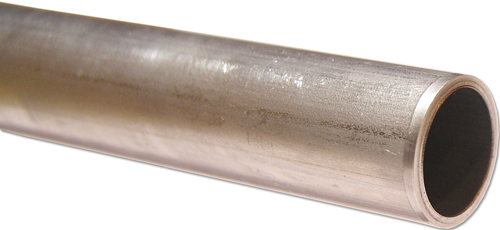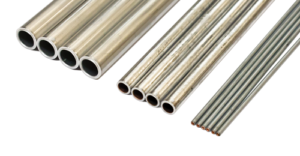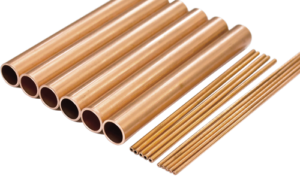ADVANTAGES OF T-DRILL CHIPLESS CUTTING

There are three different cutting methods available: Pull-apart, Through cut and Cut & Break.
The Pull-apart method is the most advanced cut-off method: first the cutting disk penetrates the tube wall by approximately 95%. The cut-length is then separated by pulling it apart. This eliminates or minimizes the I.D. reduction that could occur, if the blade was to completely cut through the tube wall.
With this feature, the secondary operations are easier to carry out since the cutting quality is usually good enough for them without deburring or chamfering tube ends. The method also allows easy chaining of different processes like cutting + endforming/bending.
The through cut method is the most fundamental method of cutting tubes by using rotary cutting disks. This method is used for cut lengths of 30 mm and longer by basic equipments. This method can be used in cases where some reduction in the internal diameter is acceptable.
The Cut & Break method is possible when tube piece length is under 70 mm. The blade is set to penetrate approximately 95 % through the tube wall, at which point the clamping fixture breaks the tube sideways. This method is only available on the T-DRILL TCC-50 RL Machine & Coil Tube Cutting Center.
T-DRILL Rotary Cut-Off machines are automated tube cutting stations with many options. They can be configured with manual length adjustments, or with fully automatic length changes with integrated batch management system. Material can be fed from multiple coil systems as well as straight sticks with integrated rack loader. Also, there are many material handling attachments for sorting, batch management and scrap reduction.
T-DRILL Cutting Machines can be equipped with NDT (Non Destructive Testing) or color detection equipment. NDT equipment can be used for detecting defects and/or joints on coiled tubing. The advanced software will remove these bad sections from the coiled tubing automatically during the cutting process. It also ensures that in such a cases tube wasted is minimized.
The model TCC-25-LM with linear motor feed technology offers rapid speed and extreme accuracy for larger volume requirements.
TYPICAL APPLICATIONS OF T-DRILL CUTTING MACHINES
Most commonly used in:
Stay competitive by integrating more operations!
The T-DRILL Rotary Cut-off Machine with in-line endformer can perform the cutting of tube simultaneously with grooving or endforming (e.g. expanding, reducing, beading, flanging, flaring etc.).
ADVANTAGES OF T-DRILL CHIPLESS CUTTING AND END FORMING
The advantage of the T-DRILL Rotary Cut-off system is that the machine maintains the nominal O.D. with burr-free I.D.
The presence of burrs would interfere with the loading of the tube to the end forming machine. In the end forming operation, burrs on either the ID or OD of the tube affect the tool’s ability to maintain tolerances or generate the final shape.
T-DRILL rotary cutting makes the secondary deburring and washing procedures unnecessary. The lead end of the tube is end formed simultaneously with the cutting operation which significantly reduces the processing time as no tube handling is required between cut-off and end forming. After processing, the tube will be either pulled or broken apart depending on the length of the product. This method guarantees significant savings, not only in time but also material.
Standard end form tooling can be used (e.g. Manchester type). The endforming happens in 1–6 phases (1–6 hits) depending on the machine type. With a 6-hit end forming machine even the most complicated tube end shapes are achievable.
In addition to handling soft materials (copper and aluminium) the machine has been developed especially to meet the requirements of harder metals, such as steel and stainless steel.


Rotary tube Cut-off with in-line Endforming accepts tubing from either straight lengths or from coil stock. Straight tubes are fed into the system automatically from a rackloader that incorporates software specially designed for minimizing tube wastage. The machine is equipped with a predetermining batch counter that turns the system off after the desired number of cuts.
Most commonly used in:
More information about different technologies:
Share on social media